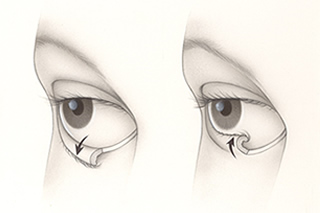Procedures
Chalaziectomy
A chalazion is a small, non-infectious lump that develops in the upper or lower eyelid due to the blockage of the meibomian gland, an oil gland in the eyelid. If it does not resolve on its own, or after treatment such as the application of warm compresses or a steroid injection, a surgical drainage procedure known as chalaziectomy may be necessary.
A chalaziectomy is performed as an outpatient procedure using local anesthesia. The chalazion is generally approached from the inside of the eyelid to ensure no visible scar will remain. Once the incision is made on the inner eyelid, the contents of the chalazion are removed. No sutures are required as the tiny incision typically heals quickly and thoroughly on its own.
Following the procedure, an antibiotic ointment will be applied and the eye is bandaged. Patients can return home soon afterward and are instructed on how long to leave the eye covering in place. Antibiotic eye drops or ointment should be used for several days after a chalaziectomy to prevent infection.
Diabetic Laser Treaments
Diabetic retinopathy is the most common type of diabetic eye disease and the leading cause of blindness in the United States. This condition is caused by blood vessel changes within the retina that lead to swelling and leaking of fluid. It can also cause the growth of abnormal new blood vessels on the surface of the retina.
In addition, the fluid can leak into the center of the macula and cause swelling and blurred vision, a condition known as macular edema. The risk of developing macular edema increases as diabetic retinopathy progresses.
For advanced stages of diabetic retinopathy, laser treatment is often effective in shrinking the abnormal blood vessels through more than a thousand laser burns in the area of the retina. This procedure, known as scatter laser treatment, usually requires two or more sessions in order to fully remove the blood vessels.
Macular edema can also be treated through a laser procedure, called focal laser treatment. This method places hundreds of laser burns in the area of retinal leakage to reduce the amount of fluid in the retina and typically only requires one session.
Laser treatments can be performed in your doctor’s office. Anesthetic eye drops will be used to minimize pain during the procedure. Patients may experience blurry vision for the remainder of the day, and should rest at home. It is important for patients to realize that these procedures cannot cure diabetic eye conditions, but rather help reduce vision loss and slow the progression for patients with more advanced cases.
DSAEK (Descemet’s Stripping Automated Endothelial Keratoplasty)
Descemet’s stripping and automated endothelial keratoplasty, known as DSAEK, is a surgical procedure that removes the abnormal inner lining of the cornea, known as the endothelium, and replaces it with a donor cornea. DSAEK offers clear post-operative vision and short recovery time to patients in need of new corneas.
Endothelial keratoplasty is performed through a much smaller incision than regular cornea transplantation resulting in a shorter recovery time and with fewer risks than a traditional corneal transplant. Recovery of vision is quicker with endothelial keratoplasty and there is less of a restriction on activities. There is less of an issue with astigmatism in an endothelial keratoplasty and there are minimal or no suture problems.
Ectropion Repair / Entropion Repair
 Entropion and ectropion are two types of eyelid problems that can cause discomfort and irritation of the eyes. They both generally require surgical repair to avoid eye health issues and potential vision loss.
Entropion and ectropion are two types of eyelid problems that can cause discomfort and irritation of the eyes. They both generally require surgical repair to avoid eye health issues and potential vision loss.
Entropion
Entropion repair surgery involves the repositioning of the eyelids. The area is numbed with a local anesthetic and sometimes light sedation is provided as well. For entropion due to muscle weakness, the surgery may involve the removal of a small section of eyelid to tighten the muscles in the area. When the entropion is caused by scars or prior surgery, the procedure typically relies on a skin graft to allow a repositioning of the eyelid.
Patients usually need to wear an eye patch for 24 hours after the surgery. Post-operatively an antibiotic and steroid ointment will need to be applied. Symptoms of entropion usually resolve immediately. There may be some short-term bruising or swelling as a result of the procedure.
Ectropion
For full correction of ectropion, a surgical procedure in which the lid is tightened is usually necessary. The area is numbed with a local anesthetic and a light sedation may also be provided. For ectropion due to muscle weakness, the surgery may involve the removal of a small section of eyelid to tighten the muscles in the area or the stretching of scar tissue. When the ectropion is caused by scars or prior surgery, the procedure typically relies on a skin graft to reposition the eyelid.
Patients usually need to wear an eye patch for 24 hours after the surgery. Post-operatively an antibiotic and steroid ointment will need to be applied. Symptoms of ectropion usually resolve immediately. There may be some short-term bruising or swelling as a result of the procedure.
Epilation with Electro Surgery
Trichiasis is a condition in which the eyelashes turn inward and irritate the eye. Treatment for trichiasis generally involves epilation, or the removal of the incorrectly positioned lashes. When a permanent solution is needed for recurrent or particularly painful eyelash problems, epilation with electrosurgery may be recommended.
Epilation with electrosurgery is a procedure that employs a radiofrequency device to permanently remove the follicles of the affected eyelashes. This is a very effective treatment method that is performed in your doctor’s office with the use of local anesthesia. A fine-wire electrode is inserted directly into each eyelash follicle that is malpositioned. An electrical current is used to destroy these follicles so that hair growth can no longer occur.






